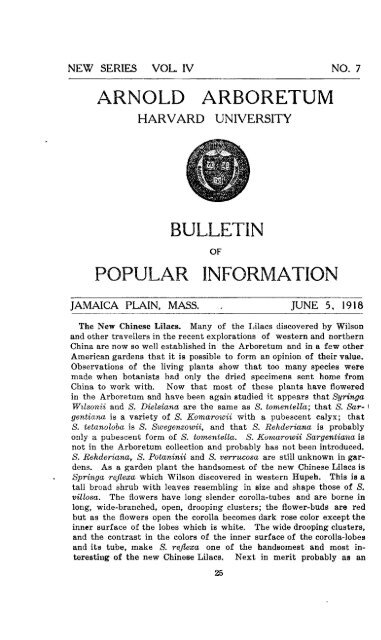Open as a single document - Arnoldia - Harvard University
Open as a single document - Arnoldia - Harvard University
Open as a single document - Arnoldia - Harvard University
You also want an ePaper? Increase the reach of your titles
YUMPU automatically turns print PDFs into web optimized ePapers that Google loves.
NEW SERIES VOL. IV NO. 7<br />
ARNOLD ARBORETUM<br />
HARVARD UNIVERSITY<br />
BULLETIN<br />
OF<br />
POPULAR INFORMATION<br />
JAMAICA PLAIN, MASS. ] JUNE 5, 1918<br />
=<br />
Springa<br />
The New Chinese Lilacs. Many of the Lilacs discovered by Wilson<br />
and other travellers in the recent explorations of western and northern<br />
China are now so well established in the Arboretum and in a few other<br />
American gardens that it is possible to form an opinion of their value.<br />
Observations of the living plants show that too many species were<br />
made when botanists had only the dried specimens sent home from<br />
China to work with. Now that most of these plants have flowered<br />
in the Arboretum and have been again studied it appears that Syringa<br />
Walsonii and S. Dielsiana are the same <strong>as</strong> S. tomentella; that S. Sargentiana<br />
is a variety of S. Komarowii with a pubescent calyx; that<br />
S. tetanoloba is S. Swegenzowii, and that S. Rehderiana is probably<br />
only a pubescent form of S. tomentella. S. Komarowii Sargentiana is<br />
not in the Arboretum collection and probably h<strong>as</strong> not been introduced.<br />
S. Rehderiana, S. Potaninii and S. verrucosa are still unknown in gardens.<br />
As a garden plant the handsomest of the new Chinese Lilacs is<br />
reflexa which Wilson discovered in western Hupeh. This is a<br />
tall broad shrub with leaves resembling in size and shape those of S.<br />
villosa. The flowers have long slender corolla-tubes and are borne in<br />
long, wide-branched, open, drooping clusters; the flower-buds are red<br />
but <strong>as</strong> the flowers open the corolla becomes dark rose color except the<br />
inner surface of the lobes which is white. The wide drooping clusters,<br />
and the contr<strong>as</strong>t in the colors of the inner surface of the corolla-lobes<br />
and its tube, make S. reflexa one of the handsomest and most interesting<br />
of the new Chinese Lilacs. Next in merit probably <strong>as</strong> an<br />
25

















